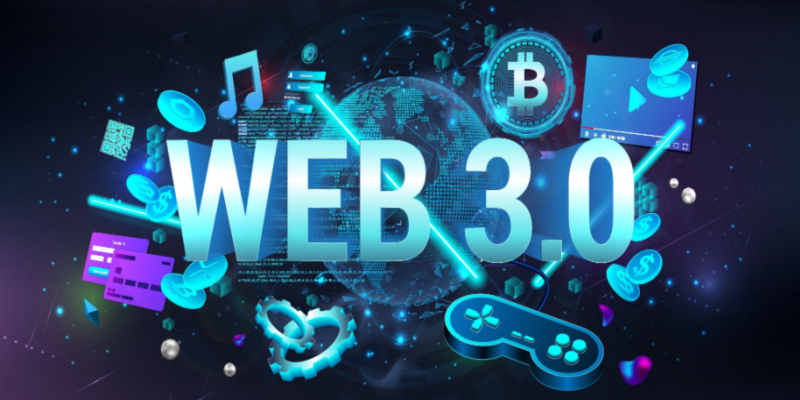A Guide to Navigating the Web3 Revolution and Blockchain Technology
Web3, the next phase of internet evolution, has emerged as a revolutionary concept that aims to reshape the way we interact, transact, and communicate online. Unlike its predecessor, Web2, which is characterized by centralized platforms and limited user control, Web3 introduces decentralized systems built on blockchain technology. This article delves into the fundamentals of Web3, highlighting its key features such as decentralization and trustless systems. It explores the potential applications of Web3 in various industries, including finance, healthcare, and more. Additionally, it examines the challenges and limitations of Web3 adoption while providing insights into the future of this paradigm shift. By embracing the Web3 revolution, we can unlock a more transparent, secure, and inclusive internet for all.
Introduction to Web3: What is it and why is it important?
Web3, short for Web 3.0, is the next generation of the internet. It promises to revolutionize the way we interact and transact online, offering a more decentralized, secure, and user-centric experience. Unlike the current Web 2.0, which relies on centralized platforms and intermediaries, Web3 empowers individuals by giving them greater control over their data and digital assets.
The Need for Web3
The need for Web3 arises from growing concerns about privacy, security, and trust in the digital world. In the current landscape, internet giants collect and monetize our personal information, leaving us vulnerable to data breaches or misuse. Web3 aims to address these issues by leveraging blockchain technology and cryptographic protocols to create a more transparent and trustless environment. By decentralizing power and enabling peer-to-peer interactions, Web3 can foster greater privacy, security, and user autonomy.
Key Features of Web3: Decentralization and Trustless Systems
Decentralized Networks
One of the defining features of Web3 is its emphasis on decentralization. Instead of relying on a single central authority, Web3 utilizes decentralized networks, often based on blockchain technology, where multiple participants validate and record transactions. This distributed nature makes Web3 more resilient to censorship, manipulation, and single points of failure.
Trustless Transactions
Web3 introduces the concept of trustless transactions, which means that parties can transact and interact without needing to trust each other. This is achieved through the use of smart contracts, self-executing agreements that automatically execute predefined conditions when met. By removing the need for intermediaries and relying on code, trust is placed in the technology itself rather than in fallible human entities.
Smart Contracts and DApps
Smart contracts are integral to Web3 and enable the creation of decentralized applications (DApps). These are applications that run on blockchain networks, leveraging the capabilities of smart contracts to automate processes and facilitate peer-to-peer interactions. DApps are designed to be open-source, transparent, and resistant to censorship, providing users with a new level of empowerment and control over their digital experiences.
Blockchain Technology: The Backbone of the Revolution
Blockchain technology forms the backbone of the Web3 revolution. It is a distributed ledger that securely records and verifies transactions across multiple computers or nodes. Each transaction, or block, is linked to the previous one, creating an immutable chain of information. This transparency and immutability of the blockchain make it a foundational technology for achieving trust and security in Web3 applications.
Blockchain Consensus Mechanisms
Consensus mechanisms play a vital role in blockchain networks by ensuring agreement among participants on the state of the blockchain. Popular consensus mechanisms include Proof of Work (PoW), where participants solve computational puzzles to validate transactions, and Proof of Stake (PoS), which assigns validation rights based on participants’ stake in the network. These mechanisms enable secure and decentralized decision-making within blockchain networks.
Interoperability and Scalability
Interoperability and scalability are key challenges that need to be addressed for widespread adoption of Web3. Interoperability refers to the ability of different blockchain networks to communicate and interact with each other seamlessly. Scalability, on the other hand, refers to the ability of blockchain networks to handle a large number of transactions quickly and efficiently. Solving these challenges is crucial for Web3 to reach its full potential and enable a truly decentralized and interconnected internet.
Applications: Exploring the Potential of Decentralized Platforms
Decentralized Finance (DeFi)
Decentralized Finance, or DeFi, is one of the most promising applications of Web3. It aims to revolutionize traditional financial systems by enabling peer-to-peer lending, decentralized exchanges, and programmable money through smart contracts. DeFi eliminates the need for intermediaries and offers users greater accessibility, transparency, and financial sovereignty.
Decentralized Identity
Decentralized identity systems leverage Web3 to give users more control over their digital identities. Instead of relying on centralized authorities to manage and validate identities, individuals can use blockchain-based systems to verify and manage their own data. This empowers users to maintain privacy, protect against identity theft, and have secure and portable identities across multiple platforms.
Decentralized Social Networks
Web3 brings a new paradigm to social networks, where users have ownership and control over their data. Decentralized social networks leverage blockchain technology to create platforms that prioritize privacy, data ownership, and user consent. Users can interact and share content without sacrificing their personal information to profit-driven centralized platforms.
Decentralized Marketplaces
Decentralized marketplaces disrupt traditional e-commerce models by removing intermediaries and enabling peer-to-peer transactions. These marketplaces built on blockchain technology empower buyers and sellers, providing transparent transactions, reduced fees, and increased security. Users can engage in commerce without relying on central platforms, fostering a more inclusive and efficient economy.
So, gear up for the Web3 revolution! It’s time to embrace a new era of decentralization, trustless systems, and user empowerment. The Web3 revolution is here, and it’s bringing a brighter, more equitable future for the internet.
Impacts on Industries: Finance, Healthcare, and more
Web3 and the Financial Sector
The advent of Web3 technology has brought about significant changes in the financial sector. Traditional financial systems are being challenged by decentralized finance (DeFi) platforms that enable peer-to-peer transactions without intermediaries. Web3 allows for increased financial transparency, lower costs, and greater accessibility for individuals who were previously excluded from the formal banking system. With the rise of cryptocurrencies and blockchain-based smart contracts, the way we think about money and financial transactions is being revolutionized.
Web3 Revolutionizing Healthcare
Web3 is not just transforming finance; it is also making waves in the healthcare industry. Through decentralized platforms, patients can have greater control over their health data and decide who can access their sensitive information. This opens up opportunities for personalized medicine, improved research collaboration, and more patient-centric healthcare systems. With the development of blockchain technology, issues such as data security and interoperability can be effectively addressed, leading to better healthcare outcomes.
Web3 in Supply Chain and Logistics
Supply chain and logistics are areas where Web3 is introducing significant advancements. The use of blockchain technology allows for greater transparency and traceability in supply chains, reducing fraud, counterfeiting, and ensuring ethical sourcing. Smart contracts enable automated and trustless interactions between different parties, streamlining processes and reducing costs. By leveraging Web3, businesses can create more efficient and sustainable supply chains, benefiting both companies and consumers.
Challenges and Limitations of Adoption
Scalability Issues
One of the main challenges facing Web3 adoption is scalability. Current blockchain networks, such as Ethereum, struggle to handle a high volume of transactions, resulting in slow and costly operations. Scaling solutions, such as layer 2 protocols and sharding, are being developed to address these limitations and improve network performance. However, widespread adoption of Web3 technology still requires significant advancements in scalability.
User Experience and Interface challenges
Another obstacle in the path to Web3 adoption is the complexity of user experience and interfaces. Interacting with decentralized applications (dApps) often involves a steep learning curve and can be confusing for non-technical users. Enhancing the user experience and providing intuitive interfaces are crucial for attracting mainstream adoption of Web3 technologies.
Regulatory and Legal Challenges
Web3 technologies operate in a complex legal and regulatory landscape. The decentralized nature of blockchain networks challenges existing regulatory frameworks, such as data privacy, financial regulations, and intellectual property rights. Governments and regulatory bodies need to adapt to this new paradigm and create clear guidelines to ensure consumer protection, fair competition, and legal certainty in the Web3 era.
The Future of Web3: Predictions and Opportunities
Advancements in Web3 Technologies
The future of Web3 holds exciting advancements in technology. As scalability improves, we can expect faster and more cost-effective blockchain networks. Upgrades in consensus mechanisms, like proof-of-stake, will enhance energy efficiency and reduce environmental impact. Additionally, the integration of artificial intelligence and Internet of Things (IoT) devices with Web3 will unlock new possibilities and enable innovative applications across various industries.
Potential Applications of Web3 in Emerging Technologies
Web3 has the potential to revolutionize emerging technologies such as virtual reality, augmented reality, and digital identity systems. By combining Web3 with these technologies, we can create immersive and secure digital experiences, enhance data privacy, and enable decentralized identity management. The possibilities are vast and will likely shape the future of our digital world.
Opportunities for Entrepreneurs and Developers
The Web3 revolution presents numerous opportunities for entrepreneurs and developers. Building decentralized applications and services on Web3 platforms allows for innovative business models, tokenization, and community-driven projects. Entrepreneurs can tap into the decentralized finance ecosystem, create decentralized marketplaces, or develop applications that solve real-world problems. Developers skilled in Web3 technologies will be in high demand as the industry continues to grow.
Embracing the Web3 Revolution for a More Transparent and Inclusive Internet
The rise of Web3 signifies a shift towards a more transparent and inclusive internet. By leveraging blockchain technology and decentralization, we can reimagine industries, empower individuals, and create systems that are fairer and more resilient. While challenges remain, the potential of Web3 to reshape finance, healthcare, supply chain, and other sectors is undeniable. Embracing the Web3 revolution will pave the way for a future where individuals have greater control over their data, transactions are more efficient, and opportunities for innovation are abundant. So, let’s dive into the Web3 revolution and shape the future of the internet together!
In conclusion, the advent of Web3 marks a significant turning point in our digital landscape. Its decentralized nature and trustless systems hold immense potential to transform various industries, enabling transparent and secure transactions while empowering individuals with greater control over their online experiences. However, the journey towards widespread Web3 adoption comes with challenges, such as scalability and regulatory concerns. Nonetheless, by embracing the Web3 revolution, we can pave the way for a more inclusive and equitable internet, where individuals have ownership of their data and interactions. It is up to us, as users, developers, and entrepreneurs, to seize the opportunities presented by Web3 and collectively shape a future that prioritizes privacy, security, and empowerment in our digital world.





